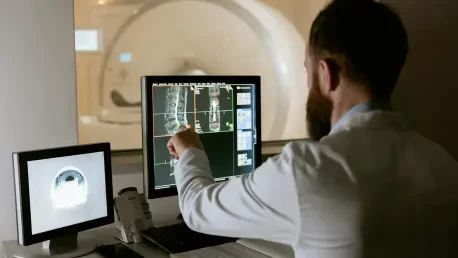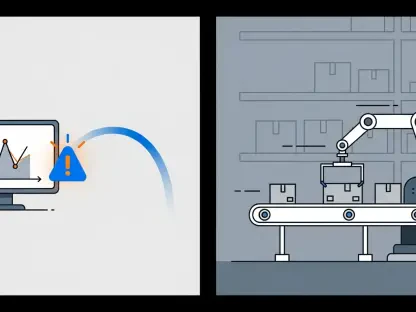In an era where healthcare systems handle billions of medical images annually, the sheer volume of data from CT scans, MRIs, and X-rays poses a monumental challenge for storage and accessibility, making innovative solutions critical. Cloud-based medical imaging has emerged as a game-changer, promising to revolutionize how hospitals and clinics manage these critical assets. This technology review delves into the intricacies of cloud imaging systems, exploring their standout features, real-world performance, and the hurdles they face in a highly regulated sector. By examining scalability, AI integration, and security concerns, this analysis aims to uncover whether this innovation truly delivers on its potential to enhance clinical workflows and patient outcomes.
Core Capabilities of Cloud Imaging Systems
Unmatched Scalability and Global Access
Cloud-based medical imaging systems stand out for their ability to scale effortlessly with the growing demands of healthcare providers. Unlike traditional on-premises storage, which often struggles with capacity constraints, cloud solutions allow organizations to store vast datasets without the burden of physical infrastructure. This scalability ensures that even small clinics can expand their imaging archives as needed, adapting to spikes in patient volume without costly upgrades.
Beyond storage, accessibility transforms how medical professionals collaborate. With cloud platforms, radiologists and specialists can retrieve images from any location, breaking down geographic barriers. This feature proves invaluable for telemedicine, enabling remote consultations and ensuring that patients in rural or underserved areas receive timely expertise, thus streamlining care delivery across diverse settings.
Harnessing Artificial Intelligence for Diagnostics
A defining strength of cloud imaging lies in its seamless integration with artificial intelligence tools. These systems leverage AI to process massive datasets, identifying patterns or anomalies in scans that might escape human observation. By hosting AI algorithms in the cloud, healthcare providers gain access to cutting-edge diagnostic support without needing powerful local hardware, democratizing advanced technology.
The performance of AI-driven cloud imaging is evident in its ability to enhance diagnostic precision. For instance, algorithms can flag potential issues in real-time, aiding clinicians in prioritizing urgent cases. Such capabilities not only reduce diagnostic errors but also accelerate decision-making, ultimately improving patient prognosis in critical scenarios like stroke or cancer detection.
Cutting-Edge Developments and Adoption Trends
Recent advancements in cloud imaging technology highlight a shift toward cloud-native ecosystems tailored for healthcare. These platforms prioritize interoperability, ensuring seamless integration with existing systems like Picture Archiving and Communication Systems (PACS) and Electronic Health Records (EHRs). This evolution minimizes disruptions during implementation, allowing health systems to modernize without overhauling their infrastructure.
Adoption rates are climbing, with a significant portion of health systems either deploying or planning to integrate cloud solutions over the next few years, from this year to 2027. This surge reflects growing confidence in the technology’s reliability, coupled with rising consumer demand for secure, instant access to medical data. Innovations in data encryption and user authentication further bolster this trend, addressing early skepticism about cloud security.
Additionally, enhanced AI capabilities continue to push boundaries. Modern cloud platforms now support more sophisticated machine learning models that adapt to specific clinical needs, offering personalized insights. These developments signal a maturing landscape where technology aligns closely with the practical demands of healthcare delivery, setting the stage for broader implementation.
Real-World Impact in Clinical Settings
Across hospitals and clinics, cloud-based imaging is proving its worth in diverse applications. Large medical centers utilize these systems for archiving extensive image libraries, ensuring long-term data preservation without the risk of physical degradation. This archival efficiency frees up resources, allowing facilities to focus on patient care rather than data management.
Remote consultations represent another compelling use case. Specialists can access high-resolution images instantly during virtual sessions, enabling second opinions or emergency assessments without patient travel. A notable example involves global health networks that connect urban hospitals with remote facilities, ensuring equitable access to expert analysis regardless of location.
Hybrid models also showcase the technology’s versatility. Some organizations maintain a mix of on-premises and cloud storage, using the latter for backup and collaborative tasks while keeping sensitive operations local. Case studies of such implementations reveal reduced downtime and improved workflow continuity, underscoring the practical benefits of tailored cloud adoption in real clinical environments.
Challenges Hindering Seamless Integration
Despite its promise, cloud imaging faces substantial obstacles, particularly around data security. The migration of sensitive patient information to distributed networks heightens the risk of breaches, necessitating robust encryption and strict access controls. Compliance with regulations like HIPAA in the United States and GDPR in Europe adds another layer of complexity, demanding constant vigilance to meet legal standards.
Performance under high demand presents a technical challenge as well. Medical imaging files are notoriously large, and delays in retrieval or processing can disrupt clinical urgency. Systems must be rigorously tested to handle peak loads without lag, as even minor hiccups can erode trust among clinicians who rely on instantaneous access during critical moments.
Hybrid environments further complicate adoption. Many facilities operate with legacy systems alongside cloud solutions, creating integration hurdles. Ensuring seamless data exchange across these setups requires meticulous testing and often custom configurations, which can strain IT resources and slow down full-scale deployment in resource-limited settings.
Final Assessment and Path Forward
Reflecting on this evaluation, cloud-based medical imaging demonstrates remarkable potential to redefine healthcare through scalability, accessibility, and AI-driven insights. Its ability to support remote collaboration and enhance diagnostics marks it as a pivotal advancement in clinical technology. However, challenges like security risks and performance bottlenecks underscore the need for continuous improvement during its rollout.
Looking ahead, stakeholders should prioritize strategic investments in robust testing frameworks to build trust in these systems. Collaborative efforts among software vendors, health systems, and regulatory bodies could drive standardized security protocols, mitigating risks. Additionally, focusing on scalable AI solutions and user training would ensure that the technology adapts to evolving clinical needs, paving the way for a more connected and efficient healthcare ecosystem.









